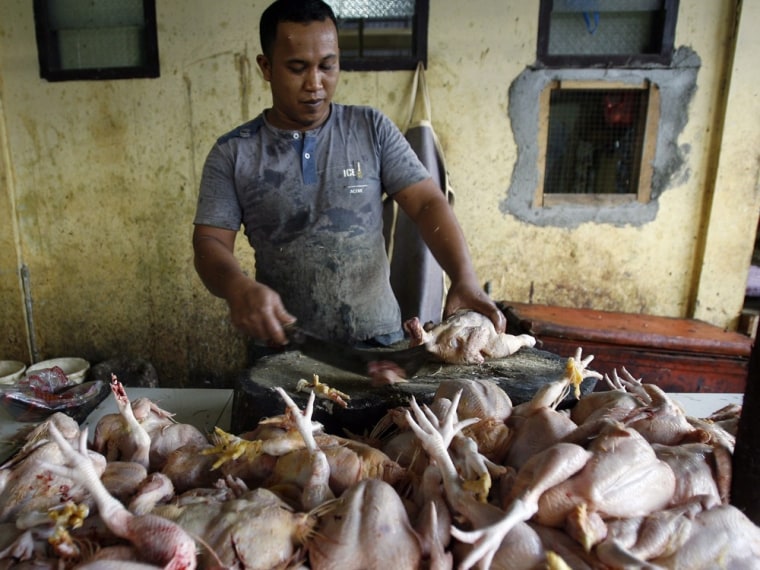Scientists said Wednesday they are re-starting some of the controversial research in which they managed to make H5N1 bird flu viruses transmit though the air -- but not in the U.S., where safety concerns haven't been fully addressed. They say they need to understand this in case it starts happening in nature, causing a pandemic.
Since 2003 H5N1 bird flu has infected 610 people globally and killed 360 of them, according to the World Health Organization. While this might not sound alarming, flu experts say it could mutate at any time into a form that passes easily from one person to another, causing a deadly pandemic. But their studied worried a board of U.S. government advisers, which asked them to hold up. They have done so for a year now.
“The risk exists in nature already, and not doing the research is really putting us in danger,” Dr. Yoshihiro Kawaoka of University of Wisconsin-Madison, one of the top influenza researchers in the world, told reporters in a telephone briefing.
Kawaoka was among 40 flu researchers who signed a letter published jointly in the journals Nature and Science on Wednesday, saying they were ready to start their work again.
The 40 scientists have been working for years to figure out just which mutations would give H5N1 the ability to spread easily from one person to another, while also staying deadly.
They mostly work with ferrets, which get infected with flu in a way very similar to how people get infected.
In one of the studies that caused concern, researchers created mutant versions of H5N1 that became airborne, spreading from one ferret to another without any physical contact.
Last December a committee called the National Science Advisory Board for Biosecurity asked two teams of researchers to hold off on publishing their findings. The U.S. government also asked all flu researchers to agree to a moratorium on genetically changing flu viruses until ground rules could be agreed on. The worry was that the virus could escape and accidentally cause a pandemic or, worse, that terrorists could somehow get hold of the work and use it to make a biological weapon.
The researchers say they’ve addressed the concerns in several countries, including Canada and the Netherlands. “Scientists should never conduct this type of research without the appropriate facilities, oversight, and all necessary approvals,” they wrote in their letter.
“The USA is still under final consideration for biosecurity,” said Dr. Ron Fouchier, who works at Erasmus University in Rotterdam, Netherlands and who conducted one of the controversial genetic engineering studies. Fouchier gets some money from the U. S. federal government but says he can re-start research using funds from the European Union and elsewhere.
H5N1 is still evolving, said Fouchier, and it’s important to understand how and when it might change. They say they can use their findings not only to keep an eye out for when the virus is beginning to get dangerous, but also to help design good vaccines and better drugs to treat flu.
“It is our opinion that in those countries where the research can be done safely, the research should start,” Fouchier said. “We simply need to re-start our research.”
“We want the world to be better prepared than we currently are when the H5N1 virus causes a pandemic,” Kawaoka agreed. “We believe the benefits of H5N1 research outweigh the risks and that is why we need to resume.”
Arthur Caplan, the head of the Division of Medical Ethics at NYT Langone Medical Center and an NBC News contributor, said it's important for researchers to learn what can make H5N1 more virulent or contagious to be better prepared in the case of a pandemic but "the real issue is where they are publishing it and who gets to see it. I have no issue with restarting the research but some issue with where they are going to publish it and where they present it because bad guys can use it too."
One thing the controversial studies found was that it only takes nine genetic mutations for H5N1 to turn from a virus that mostly infects birds into one that can easily infect mammals – including, almost certainly, humans. “Nine mutations for influenza viruses is almost none,” Kawaoka said.
While H5N1 rarely infects people, it causes regular outbreaks among chicken flocks in Asia and the Middle East, and it infects many ducks without causing any symptoms at all. As long as an influenza virus exists in an animal, it will be steadily mutating and also swapping genes with other viruses.
That’s what happened with H1N1 swine flu, which caused a pandemic in 2009. It was a never-before-seen mixture of human, pig and bird viruses. It wasn’t nearly as deadly as other new flu viruses that cause pandemics, something that could lead people to believe that flu pandemics aren’t that big a deal. But H5N1 is a completely new virus to the human body – one reason it kills such a high percentage of its human victims.
Related stories:
Bird flu more common and less deadly than believed
Bird flu mutations make it more contagious
Bird flu experiments should go on, bioethicist says
Don't miss the latest health news at NBC News.com
